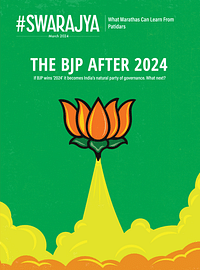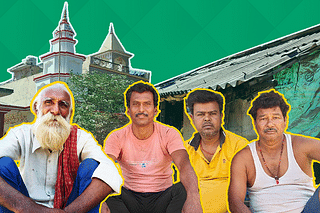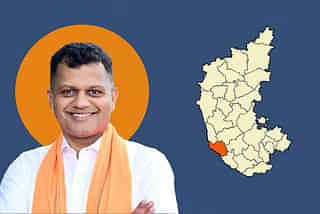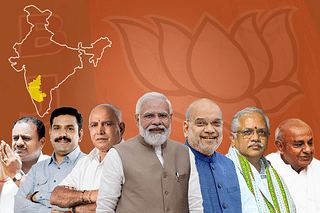Books
GMO Technologies And Various Realities
Ashok Chowgule
Aug 07, 2015, 05:49 PM | Updated Feb 11, 2016, 09:57 AM IST
Save & read from anywhere!
Bookmark stories for easy access on any device or the Swarajya app.

The decision makers need to dispassionately study the GMO technology. They need to take the lead in standing up to the anti-science activists and sift the wheat from the chaff.
Given the proven technical and commercial benefits, and no known harmful health effects, it is a surprise that there is so much opposition to the Genetically Modified Organism (GMO) technology amongst the educated people all over the world. Clearly the issue has become so emotionalised that it has been phrased as if there is a sort of war going on between two camps taking diametrically opposite views. That there could be a third choice is something that is often not often considered.
This third choice is not that one is neutral on the subject. It is that while the technology may be benign, it does not appear to give any benefits as far as an individual is concerned. Hence there does not seem to be any particular advantage in its adoption.
Reality one – the middle class
All over the world, and, in particular, the developed world, for an increasing number of educated people, hunger and lack of nutrition is no longer a reality. With the Green Revolution that Norman Borlaug fathered, the then very real threat that tens of millions dying has receded. Borlaug was deservedly the Noble Peace Prize for his work.
He thought the vast increases in productivity of many grain crops that his work made possible, gave the agriculture scientists a window in which they could develop new technologies to take care of the further problems that may arise.
What happened next were not any more breakthrough technologies like the Green Revolution, but incremental increases in productivity that saw the growing population being fed. With increased economic prosperity, the middle class had the money to buy a mix of food items, which would meet the nutritional requirements. Or buy the even more expensive nutrition supplements, often made from synthetic products when the food items available were not sufficient.
The adequate availability of food, even in drought years, has led to another reality – obesity. The middle class is looking towards eating less food, or those that are supposed to be healthy. Here the organic food industry, in trying to project their supposed natural method of farming, makes them feel that they can solve their obesity problem.
As part of their marketing strategy, the organic food industry has also subtly tried to demonise the new technology, and create an impression that GMO food is unhealthy. But potato chips, considered to be part of a menu of junk foods, have been around for a very long time before the advent of GM potatoes. The problem of junk food has to be tackled by consumer education while realising that consumption of potatoes is important of a diet in many countries. GM potatoes will help in ensuring viable farming for such purposes.
Reality two – the poor consumer
But there are countries that are still poor, and there are some people in the rich countries for whom hunger and/or lack of nutrition is a reality. However, the rest of the world sees the images of famished people only in context of a serious strife, civil or military, and not in the context of a daily life where peace exists. These images overpower the ones that exist in the non-strife situation. Thus the well-fed think that the solution is to resolve the strife and provide food aid in the meantime.
With respect to nutrition, let us consider the issue of the deficiency of vitamin A, which adversely affects the eyesight of the young, and the health of pregnant women. It is estimated that 250 million pre-school children are vitamin A deficient and that two million people die to the deficiency. Between 250,000 to 500,000 children go blind due to the deficiency, and that half of them die. But the educated people do not see these images on a regular basis.
This situation exists in some areas where rice is the staple food. The farmer does not have the income to buy the supplements, even if one can organise the logistics to deliver them to the remote areas where the farmer lives. Nor does he have the luxury to grow the necessary supplements himself since it would divert land and other resources from the income generating activity of growing rice.
Two German scientists used genetic engineering to place a gene in the rice seed, which would provide the necessary vitamin A to the consumer. This technology was then transferred to Syngenta, one of the large corporates in the GMO technology industry, for further development, by which consuming a small quantity of rice is sufficient to take care of the deficiency problem. This technology has now been transferred, free of cost, to the International Rice Research Institute, a public sector Institute in The Philippines, to make it available to the farmers at as low cost as possible,
But the anti-GMO proponents have used every trick in the book – legal, illegal, and even unethical – to thwart the conducting of field trials to fine tune the application in a real situation, so that the farmer is properly instructed. And where field trials were conducted, after passing through a thorough regulatory evaluation, they vandalised these trials. This effectively stopped the process of commercialisation of the crops.
Reality three – the farmer
A third reality is that of the farmer. In the developing countries, farming is often a subsistence level occupation, particularly where there is dependence of rain as the only source of water for the fields. With the small size of farms, the farmer may not have enough financial means to procure fertilisers and pesticides for economical farming. Hence, if the nature is even mildly unfavourable, the farmer has serious monetary problems.
Wherever the GMO technology was permitted for commercialisation, the farmers wholeheartedly accepted it. They saw the benefits, in terms of being able to increase their incomes to a level that farming becomes a viable occupation. Very often the technology is scale neutral, and the small farmer has nearly the same proportional benefits as the large one. It is also easy to use, often drastically reducing the need for one of the main inputs like pesticides.
In India, the use of GMO technology in cotton has been prevalent since 2002. The increase in the acreage under the crop has been more than 50% and the adoption rate of Bt cotton is more than 95% of the farmers. This clearly establishes that the farmer finds the technology useful to increase his income level. Today India’s share in world production has increased from 12% to more than 25%, to become the world’s largest producer (until 2009). The total production has increased by more than 250%, yield has increased by 60%, and domestic consumption by almost 80%. From zero, exports form 25% of the crop making a valuable contribution to our external trade balance. This is a success story that needs to be celebrated.
This was achieved by reducing the usage of pesticides by 70%, and improving the productivity of the rest since the yield has increased by 60%. Similarly, productivity of two other resources – water and fertiliser – also improved in a similar way. Labour productivity increased not just in terms of the increased yield, but also requiring less labour since the use of pesticides reduced dramatically. The increased cost of the seed was more than compensated by the reduced cost and increased revenue, leading to a substantially higher profit than otherwise.
This concrete example available in India can also be emulated if the GMO technology is permitted in growing Brinjal. Today, there is a heavy use of pesticides in growing the vegetable. The farmer would benefit in the same way as the cotton farmer has done by reducing the cost and increasing the revenues. The increase in supply will also benefit the consumer since the farmer can sell it at a lower price given that his cost has reduced, even as he can increase his total revenue. Today, this technology that was developed by an Indian company has now been made available in Bangladesh, with well-documented beneficial results.
Some of the GMO technologies deal not only with creating resistance to pests but also being tolerant to drought and flooding. And the technology has also been developed to insert more than one gene in the seeds so that multiple benefits can be available to the farmer. And, in all the cases, the technology is scale neutral.
Due to the proliferation of the relevant pest, in Hawaii, the Papaya crop was nearly wiped out, and in Florida, the orange crop was nearly wiped out. Both problems were resolved by the application of GMO technology, which saved a large industry as well as many jobs. In the developing countries, many of the staple diets are continuously at risk due to the pests, even where pesticides is available to deal with the problem.
Reality four – the scientists
A fourth reality is that of the scientists. A lot of pioneering work has been done by them in the private sector in India and abroad. Equally importantly, such work is also being done by government and university labs all over the world. These scientists feel frustrated by the knowledge that their work will not be put in practice for quite trivial reasons, and on the basis of anti-science. They think that will abandon their research and move into new fields, where they can see the final fruits of their work. And they will discourage younger people from venturing in the area of improving agriculture. This will mean a whole generation of scientists will not be available to the people at large to work not only on improving the quantity of food produced but also the quality.
Robert S Zeigler, the director general of the International Rice Research Institute, based in the Philippines, recently wrote in The Times of India, “The anti-science, anti-technology and anti-genetically modified organism (GMO) movements hindering the use of transgenic crops in India, such as Bt brinjal and pro-vitamin A-fortified Golden Rice (GR), are having a chilling effect on students who are now wondering if they should devote any time at all to studying agriculture and biology.”
There have been many scientists who have been vocal about the benefits of the technology. All the national level science institutes have come out forcefully in favour of the technology. But, they are not trained to use idioms that emotionally connect to the people at large. They are not comfortable to use the tactics that the opponents use and thus are not be able to effectively counter the false perceptions that have been created. Furthermore, they have to deal with a hostile media, since the journalists themselves do not face hunger and lack of nutrition, and so see no benefits of the technology for themselves as individuals. They too have been emotionalised into thinking that the GMO technology has a lot of hidden dangers.
So, we have the following four realities:
- A large and growing number of people for whom obesity, and not hunger and lack of nutrition, is a reality.
- Poor people for whom hunger and lack of nutrition is a reality.
- Farmers for whom the GMO technology will bring into reality their desire to improve their economic well-being.
- Scientists who cannot realise the reality of proving the benefits of science.
It is the views of those in the first category that dominate the views of the other three. They are a vocal section in the society, and part of a circle frequented by the decision makers – the bureaucrats and the politicians. The media, too, has uncritically publicised the arguments of the opponents of the technology. Images of supposed super-bugs, use of terminology like Frankenfood, claiming that the technology could cause cancer and other health related issues, etc. are part of the armoury that is used for emotionalisation.
Through the fog of fear, those in the first category are not able to consciously comprehend that the technology provides significant benefit to the other three categories. They have had fear instilled in them by the various tactics followed by the opponents of the GMO technology. These tactics are not just anti-science but use the classic method of scare mongering by attributing characteristics to the technology which really come out of science fiction. Visuals are used that one sees in comics, or in movies using a lot of computer generated animation.
GMO technology does not change the essential nature of the product that is produced with the conventional system. What the technology does is enable the plant to have characteristics that help in dealing with the problems in nature, which are today handled, less efficiently, by other means. There is no reduction in the nutritional value in case of crops.
At the same time, the alternative of not using the technology is rarely presented. In fact, just as the farmer (traditionally a poor person in developing countries) will benefit in monetary terms by the technology, the better-off non-farmer will also benefit because it expands the market for the products they make, or the services that they render on a professional basis. This growth in the economy is actually a win-win situation.
The technology is also more environmentally friendly and hence would lead to a more sustainable form of agriculture. Apart for the better use of resources mentioned above, there has been a lesser need to deforest in South America because the present land occupied is producing more. Many of the staple crops in the poor countries of are often destroyed by pests. This can be easily controlled by the GMO technology, without any additional inputs of water, fertilisers or pesticides.
The ones in the first category are also proponents of preventing environmental degradation. Hence, their opposition to GMO becomes that much more difficult to understand. They have been the beneficiaries of the GMO technology in items like flowers (for example, the long-stemmed roses). They are clamouring for more of the genetic engineering technology to be used in medicines and health science. But an irrational fear has been instilled in them when it comes to food.
What is needed is for the educated people, particularly the decision makers, to dispassionately study the technology. They need to take the lead in standing up to the anti-science activists, and sift the wheat from the chaff. They should have the political courage to explain to the people the benefits of the technology. They should follow the example of the agriculture minister of Bangladesh, Matia Chowdhury who took the bold decision to side with her scientists, and against the anti-science NGOs, to allow Bt Brinjal to be grown in her country.
This political courage is happening slowly in the developing countries, with a greater realisation that hunger and/or lack of nutrition is a reality for the poor. And the only way to resolve the issue is to utilise science in agriculture. Furthermore, the scientists teaching at the universities in their own countries have also been working on the GMO technology and have conducted tests which confirm the safety as claimed, by the large, multi-national companies. These scientists have rightly looked at how their own countries will benefit, rather than worry how much profits the corporate sector is earning.
Given the research that has already taken place in the public and private sector over the last twenty/thirty years, there are many products that are waiting to be released in the field. These will lead to intelligent farming in terms of optimising the use of all the resources – land, fertilisers, pesticides, water, labour, fuel, etc. – that are in use. This will also make farming environmentally sustainable, and also deal with the fear of a water crisis that is said to be looming. And, most importantly, feed the nine billion people in terms of quantity and nutritional values. Let the reality not be of one of hunger.
(Note: The views and perspectives expressed in this note are those that I obtained by reading articles, and seeing videos, of various scientists involved in the development of GMO technology. There are too many for me to list. As a general comment, I would like to state that I am grateful to the scientists for providing me with so much information. I am personally not a scientist and have no financial interest in the industry. I have studied the technology from a point of economic development of countries, particularly India.)
Save & read from anywhere!
Bookmark stories for easy access on any device or the Swarajya app.
Ashok Chowgule is the Working President (External) of Vishwa Hindu Parishad. He is indebted to Ram Swarup and Sita Ram Goel, and many others whom these great souls have influenced, for understanding the essence of Hinduism. It is in this understanding that this note was prepared.
Introducing ElectionsHQ + 50 Ground Reports Project
The 2024 elections might seem easy to guess, but there are some important questions that shouldn't be missed.
Do freebies still sway voters? Do people prioritise infrastructure when voting? How will Punjab vote?
The answers to these questions provide great insights into where we, as a country, are headed in the years to come.
Swarajya is starting a project with an aim to do 50 solid ground stories and a smart commentary service on WhatsApp, a one-of-a-kind. We'd love your support during this election season.
Click below to contribute.







